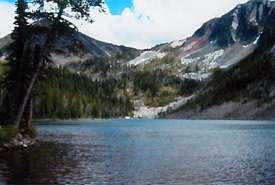Conservation as a pathway to sustainability

Wolf Lake (Photo by John Anonby)
Few of us need to be convinced that there is an important connection between a healthy natural environment and improved human health. But what is perhaps less obvious is nature’s connection with other pressing societal issues. This is precisely the type of connection that the United Nations’ Sustainable Development Goals (SDGs) have been designed to highlight. They call attention to the important role that nature and the many benefits it provides (often referred to as ecological goods and services) play in meeting the needs of more than seven billion people worldwide.
Connecting nature conservation to broader societal goals is rapidly emerging as an important means of communicating the impact of an organization like the Nature Conservancy of Canada (NCC) in meeting many of the world’s challenges. To date, 193 countries have signed on to support the United Nations’ 2030 Sustainable Development Agenda, an action plan with 17 high-level SDGs. These SDGs include targets and indicators against which to measure global social, economic and environmental progress.
The International Union for the Conservation of Nature (IUCN) is one of the world’s leading conservation organizations. It has actively embraced the link between nature and the achievement of many SDGs. Many global issues can only be properly addressed when the conservation and sustainable use of the world’s natural resources are given appropriate consideration.
For example, in order to address a goal such as zero hunger (SDG 2), we need clean water for irrigation of crops as well as for drinking. Clean water, in turn, is dependent upon the conservation of healthy ecosystems (SDGs 14, life under water, and 15, life on land). And both life under water and on land are being affected by climate change (SDG 13). The connections between these SDGs is becoming increasingly obvious.
But what does all of this mean for NCC?
Well, first and foremost, SDGs provide NCC with an opportunity to reframe the conservation discussion. These SDGs can be used to highlight the importance of conserving nature as a means of, for example, addressing some of the adverse effects of climate change. At the same time, NCC’s work already provides important co-benefits to society that directly contribute to the achievement of many of these SDGs.
When working to conserve large-scale natural landscapes and habitat for threatened species, such as those found at Darkwoods in British Columbia, NCC’s actions directly contribute to a number of these SDGs. Conservation can lead to protection of freshwater ecosystems, conserving habitat for threatened species, increasing land connectivity to help species adapt to climate change, providing jobs to local communities and much more.
The inter-relationship between many of the SDGs broadens the impact of conservation, so that conservation’s role in addressing health issues or addressing climate change, to cite just two examples, can be demonstrated by conserving clean water and protecting life on land through conserved areas. Conservation can be seen as a pathway to sustainability, in turn facilitating the achievement of many of these universally recognized Sustainable Development Goals.
The conservation of nature cannot singlehandedly solve all of the societal issues addressed through the SDGs. However, conservation can certainly be used to demonstrate how society, the economy and the environment can work hand in hand towards a better world.



